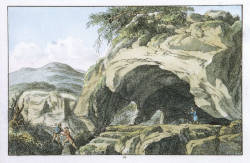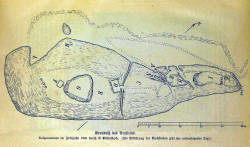Arnsteinhöhle
Useful Information
| Location: |
Buschmühle in the Kirnitzschtal valley, 45 minute ascend.
(50.929229, 14.289981) |
| Open: |
No restrictions. [2010] |
| Fee: |
free. [2010] |
| Classification: |
 Sandstone Caves Sandstone Caves
|
| Light: | bring torch |
| Dimension: | |
| Guided tours: | self guided |
| Photography: | allowed |
| Accessibility: | no |
| Bibliography: | |
| Address: | |
| As far as we know this information was accurate when it was published (see years in brackets), but may have changed since then. Please check rates and details directly with the companies in question if you need more recent info. |
|
History
| 14th century | Castle built by the Bohemian nobles Berkové z Dubé. |
| 04-AUG-1436 | Castle Arnstein first mentioned in documents. |
| 1436 | Besiege by the Electorate of Saxony and the League of Six Cities. |
| 17-AUG-1437 | Renewed siege of the castle by the Saxon princes and Heinrich von der Dubá. |
| 1451 | Castle destroyed. |
| 1987-88 | Excavations in the cistern. |
Description


The Arnsteinhöhle was named after the Arnstein (327 m NN), a rock massif in the Saxon Switzerland at the confluence of the Dorfbachgrund descending from Ottendorf and the Kirnitzsch. From the Buschmühle in the south of the Arnstein, a hiking trail leads up to the summit and the cave. The Arnstein Cave was included in the construction of Arnstein Castle, popularly known as Ottendorfer Raubschloss (Ottendorf Robber’s Castle). Among the rocks, you can still find the remains of the former fortification, which were built in the 14th century. Rock cut steps, rock drawings and a 5 m deep cistern are preserved. Beam bearings and rock clamps are the only remains of the former keep. However, the interpretation of a cavity as a castle dungeon is probably a romantic fantasy. A model of the fortress is on display in the Bad Schandau museum.
In the 14th and early 15th centuries, the keep, the residential and kitchen buildings, the gateways of the core castle and the farm buildings and fortifications of the outer castle were built. At that time, the castle was one of the most important fortresses in Saxon Switzerland. It was only slightly smaller than the neighbouring Wildenstein Castle.
The castle was first mentioned in a document on 04-AUG-1436 when it was mortgaged by the owner Berkové z Dubé to the Bohemian nobleman Siegmund von Wartenberg from Tetschen. However, he was a robber baron and undertook raids on Saxon and Bishop of Meissen territory and threatened the trade routes of the Upper Lusatian six towns. In the same year, the castle was therefore besieged by the Electorate of Saxony and the League of Six Cities. The knight surrendered and signed a truce. On 19-OCT-1436, a peace treaty followed before Emperor Sigismund in Prague. However, a henchman of the knight, the Tetschen burgher Rauchfuß, called Bauerfeind continued the raids. Six villages, including Krippen, Schöna and Reinhardtsdorf, lost all their livestock and the villagers were imprisoned on the Arnstein. On 17-AUG-1437, the Saxon princes allied with Heinrich von der Dubá of Wildenstein. The castle was again besieged and burnt down when it was conquered. To prevent further fighting, Siegmund von Wartenberg had to sell the castle to the Elector of Saxony for 500 groschen.
The castle was given back to the Berkové z Dubé. However, they apparently knew little about what to do with it and only had it provisionally rebuilt. The lowest rock of the core castle was abandoned and the entrance was moved directly from the outer castle to the middle core castle. The castle could now only be entered through a narrow and difficult-to-pass crevice in the rock. Soon afterwards it became the property of Saxony and was subsequently abandoned. It was finally destroyed in 1451.
The last robber baron was put on the wheel on a rock off to the south and met a gruesome death.
He had hidden a treasure in the castle, but never revealed the hiding place.
The treasure was searched for but never found.
The legend of Arnstein Castle.
Based on the legend, excavations were carried out in the cistern in 1987/88. However, no treasure was found.
- See also
 Search DuckDuckGo for "Arnsteinhöhle"
Search DuckDuckGo for "Arnsteinhöhle" Google Earth Placemark
Google Earth Placemark Burg Arnstein (Sachsen)
Burg Arnstein (Sachsen)  - Wikipedia (visited: 01-APR-2021)
- Wikipedia (visited: 01-APR-2021) Arnstein - Ottendorfer Raubschloss
Arnstein - Ottendorfer Raubschloss  (visited: 01-APR-2021)
(visited: 01-APR-2021) Die Raubschlosstour – Über den Lorenzstein zum Hinteren und Ottendorfer Raubschloss
Die Raubschlosstour – Über den Lorenzstein zum Hinteren und Ottendorfer Raubschloss  (visited: 01-APR-2021)
(visited: 01-APR-2021) Arnstein
Arnstein  (visited: 01-APR-2021)
(visited: 01-APR-2021)
 Index
Index Topics
Topics Hierarchical
Hierarchical Countries
Countries Maps
Maps